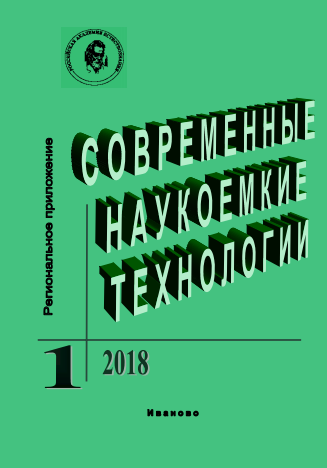СЕНСОРНЫЕ ХАРАКТЕРИСТИКИ ЖИДКОКРИСТАЛЛИЧЕСКИХ ПОЛУПРОВОДНИКО-ВЫХ ПЛЁНОК ФТАЛОЦИАНИНА КОБАЛЬТА
Аннотация
В статье представлены результаты исследования сенсорных характеристик жидкокристаллических слоёв фталоцианина кобальта CoPc-py в широком интервале концентраций аммиака. Показана высокая чувствительность плёнок к аммиаку вплоть до концентраций в 50 раз ниже ПДК, хорошая воспроизводимость сенсорного отклика, низкая инерционность отклика, линейный диапазон зависимости аналитический сигнал/концентрации аммиака составляет 0,1–20 ppm. Впервые изучена селективность детекции аммиака в присутствии углекислого газа и водорода. Установлено, что при нормативных концентрациях СО2 в помещении (до 2000 ppm) и при 10000 ppm водорода сенсорный отклик на аммиак изменялся в пределах статистической погрешности. Статья публикуется по результатам проведения научно-исследовательской работы, проводимой в рамках конкурса грантов на выполнение научно-исследовательских работ научно-педагогическими работниками СПбГАСУ в 2022 году.
Литература
1. Schöllhorn B., Germain J.P., Pauly A., Maleysson C., Blanc J.P. Influence of peripheral electron-withdrawing substituents on the conductivity of zinc phthalocyanine in the presence of gases. Part 1: reducing gases. Thin Solid Films. 1998. V. 326, P. 245–250. https://doi.org/10.1016/S0040-6090(98)00553-7.
2. Germaina J.P., Paulya A., Maleyssona C., Blanc J.P., Schöllhorn B. Influence of peripheral electron-withdrawing substituents on the conductivity of zinc phthalocyanine in the presence of gases. Part 2 : oxidizing gases. Thin Solid Films. 1998, V. 333. P. 235–239.
3. Dong Z., Kong X., Wu Y., Zhang J., Chen Y. High-sensitive room-temperature NO2 sensor based on a soluble n-type phthalocyanine semiconductor. Inorg. Chem. Commun. 2017. V. 77. P. 18–22. https://doi.org/10.1016/j.inoche.2017.01.023.
4. Erbahar D.D., Harbeck M., Gümüş G., Gürol I., Ahsen V. Self-assembly of phthalocyanines on quartz crystal microbalances for QCM liquid sensing applications. Sensors Actuators B Chem. 2014. V. 190. P. 651–656. https://doi.org/10.1016/j.snb.2013.09.034.
5. Hassan A., Basova T., Yuksel F., Gümüş G., Gürek A.G., Ahsen V. Study of the interaction between simazine and metal-substituted phthalocyanines using spectral methods. Sensors Actuators, B Chem. 2012. V. 175. P. 73–77. https://doi.org/10.1016/j.snb.2011.12.029.
6. Wohltjen H. Mechanism of operation and design considerations for surface acoustic wave device vapour sensors. Sensors and Actuators. 1984. V. 5, P. 307–325. https://doi.org/10.1016/0250-6874(84)85014-3.
7. Brunet J., Pauly A., Mazet L., Germain J.P., Bouvet M., Malezieux B. Improvement in real time detection and selectivity of phthalocyanine gas sensors dedicated to oxidizing pollutants evaluation. Thin Solid Films. 2005. V. 490. P. 28–35. https://doi.org/10.1016/j.tsf.2005.04.015.
8. Wang B., Wu Y., Wang X., Chen Z., He C. Copper phthalocyanine noncovalent functionalized single-walled carbon nanotube with enhanced NH3 sensing performance. Sensors Actuators B Chem. 2014. V. 190. P. 157–164. https://doi.org/10.1016/j.snb.2013.08.066.
9. Zhao L., Zhu S., Zhou J. A novel amperometric nitric oxide sensor based on imprinted microenvironments for controlling metal coordination. Sensors Actuators B Chem. 2012. V. 171–172. P. 563–571. https://doi.org/10.1016/j.snb.2012.05.035.
10. Viricelle J.P., Pauly A., Mazet L., Brunet J., Bouvet M., Varenne C., Pijolat C. Selectivity improvement of semi-conducting gas sensors by selective filter for atmospheric pollutants detection. Mater. Sci. Eng. C. 2006. V. 26. P. 186–195. https://doi.org/10.1016/j.msec.2005.10.062.
11. Jakubik W., Urbanczyk M., Maciak E. Metal-free phthalocyanine and palladium sensor structure with a polyethylene membrane for hydrogen detection in SAW systems. Sensors Actuators B Chem. 2007. V. 127. P. 295–303. https://doi.org/10.1016/j.snb.2007.07.026.
12. Rangel Argote M., Sánchez Guillén E., Gutiérrez Porras A.G., Serrano Torres O., Richard C., Zagal J.H., Bedioui F., Gutierrez Granados S., Griveau S. Preparation and Characterization of Electrodes Modified with Pyrrole Surfactant, Multiwalled Carbon Nanotubes and Metallophthalocyanines for the Electrochemical Detection of Thiols. Electroanalysis. 2014. V. 26. P. 507–512. https://doi.org/10.1002/elan.201300578.
13. Kılınç N., Atilla D., Öztürk S., Gürek A.G., Öztürk Z.Z., Ahsen V. Oxidizing gas sensing properties of mesogenic copper octakisalkylthiophthalocyanine chemoresistive sensors. Thin Solid Films. 2009. V. 517. P. 6206–6210. https://doi.org/10.1016/j.tsf.2009.04.005.
14. Kılınç N., Atilla D., Gürek A.G., Öztürk Z.Z., Ahsen V. Volatile organic compounds sensing properties of tetrakis(alkylthio)-substituted lutetium(III) bisphthalocyanines thin films. Talanta. 2009. V. 80, P. 263–268. https://doi.org/10.1016/j.talanta.2009.06.064.
15. Sisman O., Kilinc N., Akkus U.O., Sama J., Romano-Rodriguez A., Atilla D., Gürek A.G., Ahsen V., Berber S., Ozturk Z.Z. Hybrid liquid crystalline zinc phthalocyanine@Cu2O nanowires for NO2 sensor application. Sensors Actuators B Chem. 2021. V. 345. P. 130431. https://doi.org/10.1016/j.snb.2021.130431.
16. Shi J., Luan L., Fang W., Zhao T., Liu W., Cui D. High-sensitive low-temperature NO2 sensor based on Zn (II) phthalocyanine with liquid crystalline properties. Sensors Actuators, B Chem. 2014. V. 204. P. 218–223. https://doi.org/10.1016/j.snb.2014.07.070.
17. Kaya E.N., Polyakov M.S., Basova T.V., Durmuş M., Hassan A. Pyrene containing liquid crystalline asymmetric phthalocyanines and their composite materials with single-walled carbon nanotubes. J. Porphyr. Phthalocyanines. 2018. V. 22. P. 56–63. https://doi.org/10.1142/S1088424618500025.
18. Gülmez A.D., Polyakov M.S., Volchek V.V., Kostakoğlu S.T., Esenpinar A.A., Basova T.V., Durmuş M., Gürek A.G., Ahsen V., Banimuslem H.A., Hassan A.K. Tetrasubstituted copper phthalocyanines: Correlation between liquid crystalline properties, films alignment and sensing properties. Sensors Actuators, B Chem. 2017. V. 241. P. 364–375. https://doi.org/10.1016/j.snb.2016.10.073.
19. Klyamer D., Sukhikh A., Gromilov S., Krasnov P., Basova T. Fluorinated Metal Phthalocyanines: Interplay between Fluorination Degree, Films Orientation, and Ammonia Sensing Properties. Sensors. 2018. V. 18. P. 2141. https://doi.org/10.3390/s18072141.
20. Kaya E.N., Şenocak A., Klyamer D.D., Demirbaş E., Basova T.V., Durmuş M. Ammonia sensing performance of thin films of cobalt(II) phthalocyanine bearing fluorinated substituents. J. Mater. Sci. Mater. Electron. 2019. V. 30. P.7543-7551. https://doi.org/10.1007/s10854-019-01068-8.
21. Kaya E.N., Tuncel S., Basova T.V., Banimuslem H., Hassan A., Gürek A.G., Ahsen V., Durmuş M. Effect of pyrene substitution on the formation and sensor properties of phthalocyanine-single walled carbon nanotube hybrids. Sensors Actuators, B Chem. 2014. V. 199. P. 277–283. https://doi.org/10.1016/j.snb.2014.03.101.
22. Sukhikh A.S., Polyakov M.S., Klyamer D.D., Gromilov S.A., Basova T.V. A study of the structural features and sensor properties of zinc 2,9,16,23-tetra-tert-butylphthalocyanine films. J. Struct. Chem. 2017. V. 58. P. 1039-1047. https://doi.org/10.1134/S0022476617050262.
23. Wang B., Zhou X., Wu Y., Chen Z., He C. Lead phthalocyanine modified carbon nanotubes with enhanced NH3 sensing performance. Sensors Actuators B Chem. 2012. V. 171–172. P. 398–404. https://doi.org.
24. Robertson D. S. Health effects of increase in concentration of carbon dioxide in the atmosphere. Current Science. 2006. Vol. 90. Is. 12. P. 1607–1609.














